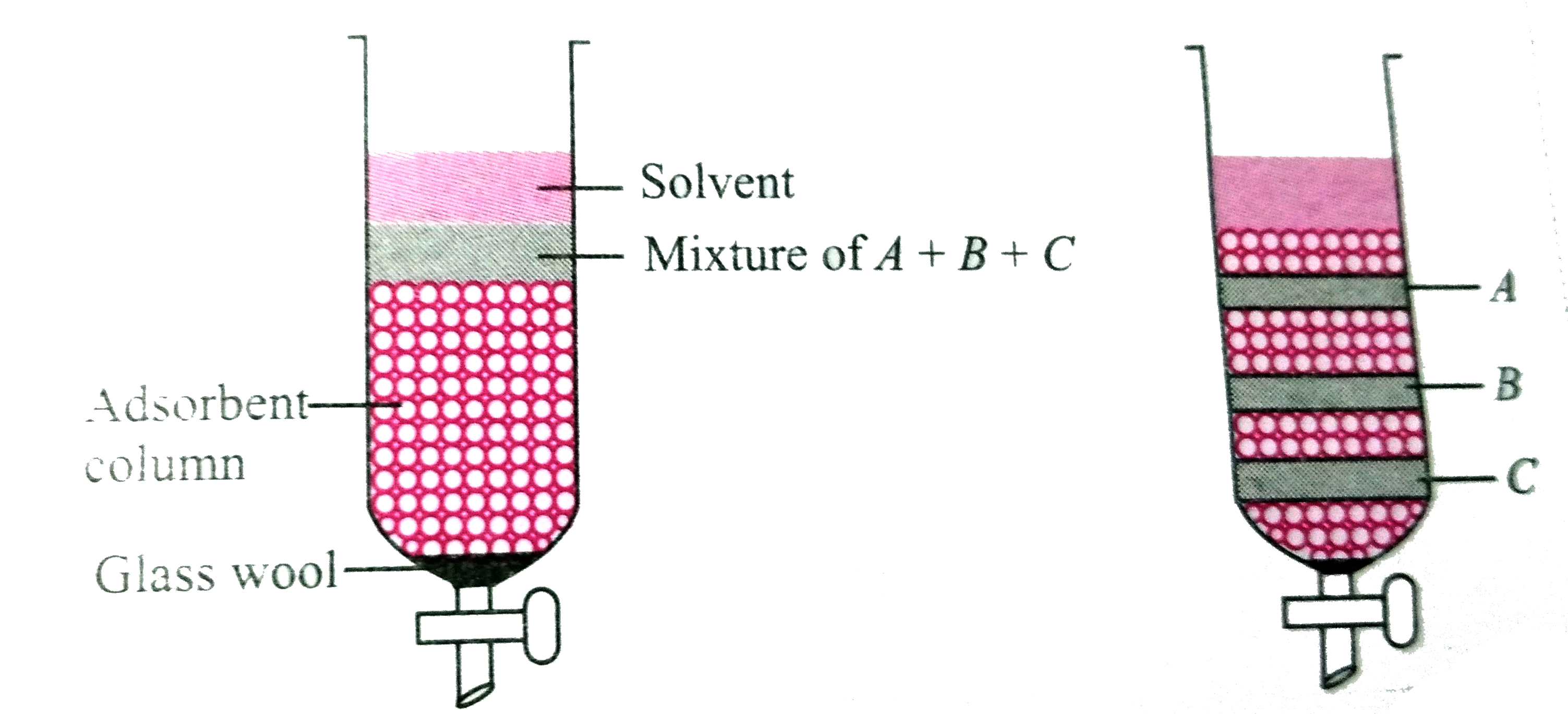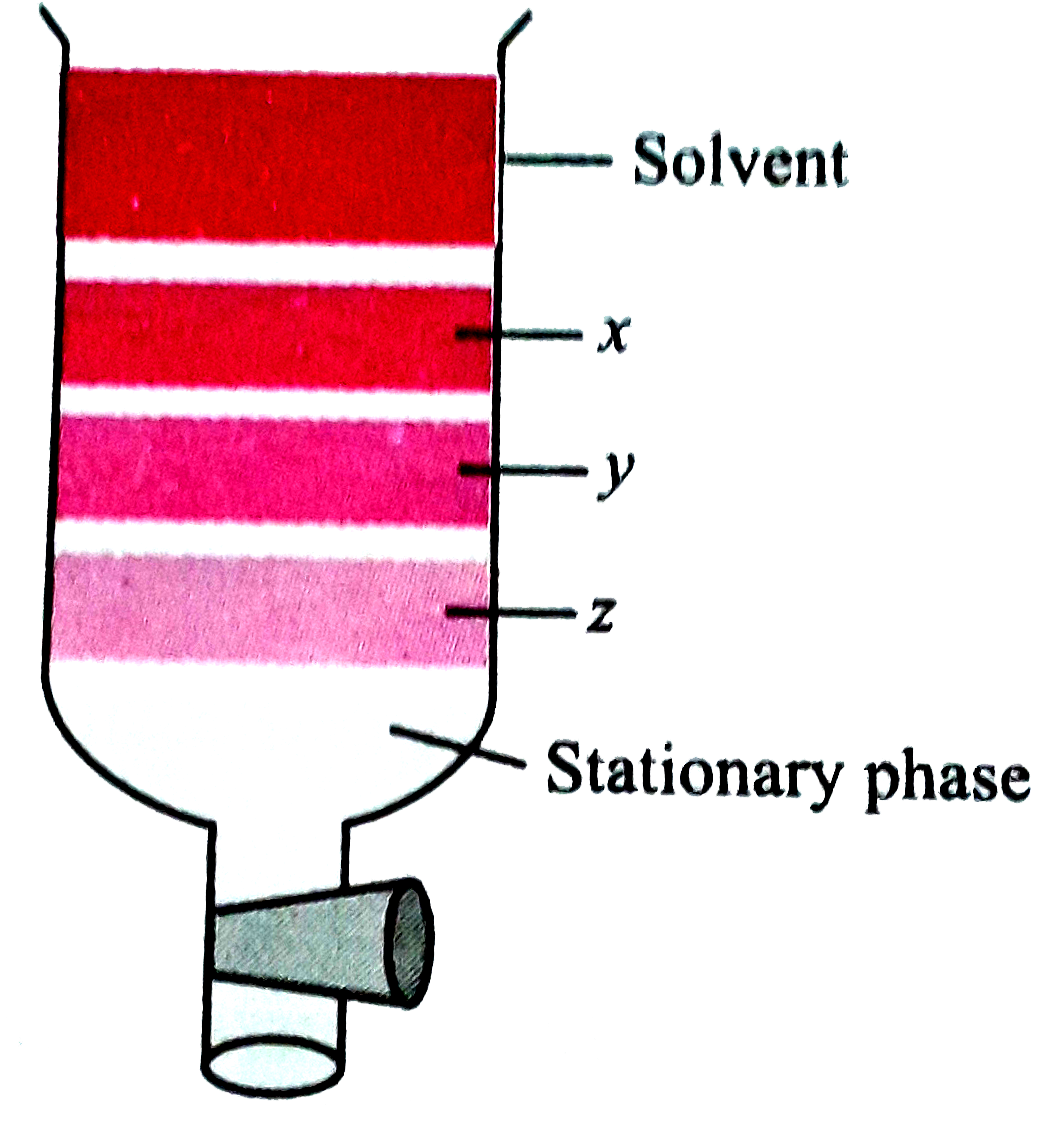A chromatography column, packed with silica gel as stationary phase, was used to separate a mixture of compounds consisting of (A) benzanilide (B) aniline and (C) acetophenone. When the column is eluted with a mixture of solvents, hexane : ethyl acetate (20 : 80), the sequence of obtained compounds is
(B), (C) and (A)
(B), (A) and (C)
(A), (B) and (C)
(C), (A) and (B)
The correct Answer is:4
To solve the problem of separating a mixture of compounds (A) benzanilide, (B) aniline, and (C) acetophenone using a chromatography column packed with silica gel and eluted with a mixture of solvents (hexane: ethyl acetate in a 20:80 ratio), we can follow these steps:
Step 1: Understand the Compounds
- Benzanilide (A): This compound has both a benzene ring and an amide functional group, making it relatively polar.
- Aniline (B): Aniline contains an amino group (-NH2) attached to a benzene ring, which also makes it polar.
- Acetophenone (C): This compound has a ketone functional group (C=O) attached to a benzene ring, making it polar as well.
Step 2: Identify the Polarity of the Solvents
- Hexane: A non-polar solvent.
- Ethyl Acetate: A polar solvent.
Step 3: Analyze the Mixture and Solvent Composition
The solvent mixture is 20% hexane (non-polar) and 80% ethyl acetate (polar). Since the polar solvent is in greater quantity, it will preferentially interact with the more polar compounds in the mixture.
Step 4: Determine the Order of Elution
In column chromatography, the order of elution is determined by the polarity of the compounds:
- The more polar compounds will interact more with the polar solvent (ethyl acetate) and will elute first.
- The less polar compounds will interact more with the stationary phase (silica gel) and will elute later.
Step 5: Rank the Compounds by Polarity
1. Acetophenone (C): Most polar due to the presence of the ketone group.
2. Aniline (B): Polar due to the amino group.
3. Benzanilide (A): Least polar compared to the others due to the presence of the amide group but still polar.
Step 6: Write the Sequence of Elution
Based on the above analysis, the sequence of elution from the chromatography column will be:
1. Acetophenone (C) - elutes first
2. Aniline (B) - elutes second
3. Benzanilide (A) - elutes last
Final Answer
The sequence of obtained compounds is: C (Acetophenone), B (Aniline), A (Benzanilide).
---
- Benzanilide (A): This compound has both a benzene ring and an amide functional group, making it relatively polar.
- Aniline (B): Aniline contains an amino group (-NH2) attached to a benzene ring, which also makes it polar.
- Acetophenone (C): This compound has a ketone functional group (C=O) attached to a benzene ring, making it polar as well.
- Hexane: A non-polar solvent.
- Ethyl Acetate: A polar solvent.
The solvent mixture is 20% hexane (non-polar) and 80% ethyl acetate (polar). Since the polar solvent is in greater quantity, it will preferentially interact with the more polar compounds in the mixture.
In column chromatography, the order of elution is determined by the polarity of the compounds:
- The more polar compounds will interact more with the polar solvent (ethyl acetate) and will elute first.
- The less polar compounds will interact more with the stationary phase (silica gel) and will elute later.
1. Acetophenone (C): Most polar due to the presence of the ketone group.
2. Aniline (B): Polar due to the amino group.
3. Benzanilide (A): Least polar compared to the others due to the presence of the amide group but still polar.
Based on the above analysis, the sequence of elution from the chromatography column will be:
1. Acetophenone (C) - elutes first
2. Aniline (B) - elutes second
3. Benzanilide (A) - elutes last
The sequence of obtained compounds is: C (Acetophenone), B (Aniline), A (Benzanilide).
Topper's Solved these Questions
Similar Questions
Given below is a column ot adsorbent in which the mixture of compounds A+B+C is placed. When the solvent is poured through the column, the components are separated depending upon the degree of adsorption. Which of the given statements is correct?

View SolutionThe mixture of compounds A and B is passed through a column of Al2O3 by using alcohol as eluent. Compound A is eluted in preference to compound B. Which of the compounds A or B is more readily adsorbed on the column?
View Solution
Knowledge Check
During a column chromatography through Al2O3 column, a mixture of components A,B and C is passed through the column. On adding eluant, compound 'A' is eluted first then 'B' and in the end 'C'. Which of the following statements regarding the components is correct ?
AThe order of adsorption of A, B and C is C>B>ABThe order of adsorption of A,B and C is A>B>CCThe order of adsorption of A,B and C is B>A>CDThe order of adsorption of A, B and C is B>C>A
Column chromatography involves separation of a mixture over a column of adsorbent (stationary phase) packed in a glass tube. Depending upon the degree of adsorption complete separation takes places . In the given column, three coloured bands x, y, z are formed . Identify the correct statement .

View Solution(a) how is a mixture of two organic compounds separated, which have different solubilities in the ame solvent?
(b) How is an organic liquid purified which decomposes below its boiling point?
(c) Why is sodium extract boiled with HNO3 before testing for halogens?
(d) What type of organic compounds cannot be estimated by Kjeldahl's method?
(e). What does blood-red colouration during Lassaigne's test indicate?
(f). What happens when AgNO3 solumtion is added to bromo methane?
View SolutionAt high temperature, carbon reacts with water to produce a mixture of CO and H2.
C+H2OHeat heat−−−−−→CO+H2
CO is separated from H2 and then used to separate Ni from CO by forming a volatile compound, nickel tetracarbonyl (Ni(CO)4).
Ni+4CO→Ni(CO)4
(a) Formation of volatile Ni(CO)4 and its subsequent heating give pure Ni. Name the process involved.
(b) How many moles of Ni(CO)4 could be obtained from CO produced by the reaction of 75.0g is carbon ?
View Solution
